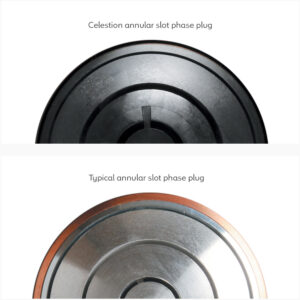
Celestion’s research department created a unique way of improving the performance of a compression driver, leading to a patented new design for phase plugs. We call it Maximum Modal Suppression.
Many of Celestion’s latest compression driver products now feature a unique design of phase plug, developed using patent-applied-for design methodology that greatly reduces the occurrence of “cavity resonances”.
Used in tandem with this new phase plug is a “deep-drawn” titanium diaphragm to increase the overall stiffness of the membrane.
Together, these innovative new features result in more accurate sounding compression drivers that exhibit much lower distortion than many typical high-frequency devices currently available.
This technology has been deployed in the CDX14-3055, CDX14-3050, CDX14-2420, CDX14-2410, CDX1-1720 and CDX1-1740 compression drivers.
A New Landmark in Compression Driver Design
In 1953, Bob Smith recognised the limitations of the “Equal Path Length” method for calculating the width and position of annular phase plug slots. He developed a set of criteria for determining these dimensions which more effectively suppressed modal excitation to achieve lower distortion. Smith’s methodology has now been the established technique for annular phase plug design for over 50 years.
With Smith’s work as their start point, Celestion engineers Mark Dodd and Jack Oclee-Brown looked further into modal decomposition as applied to a curved diaphragm. Possibly the most significant development in annular phase plug design in over 50 years, their new design criteria re-define the ratios used to calculate slot width and position, resulting in greater modal suppression and reduced air non-linearity.
Originally applied to the development of the phase plug for the CDX14-3050 compression driver, this new design methodology re-calculates slot width and slot positioning ratios. The result is improved modal suppression within the phase plug, and hence lower distortion. The photographs below demonstrate the variation of slot width ratios, compared to that of a typical phase plug design, which is the principal characteristic of the new Celestion design.


